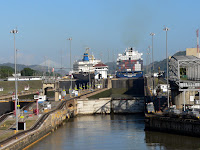 |
| Miraflores Lock |
7am The first of three pilots for the transit came aboard. One of the rare occasions where a captain hands over the direction of his vessel to someone else. We glided past Panama City, with its towering skyscrapers to starboard, and the leper colony to port, where five inhabitants remain. One who had been transported there as young as 10 is now 75, and the colony has been her only home.
We would be raised up to the level of the Gatun Lake by two locks, called the MiraFlores, sail into the Gatun Lake, and the dropped back down to the level of the Atlantic Ocean by two more locks called the Pedro Miguel Locks. Each time the locks are drained to lower the vessel, water is lost, but then recycled for the use ib the city- 26million gallons per lock- so 52million gallons in total. No wonder one other priority in the present expansion of the canal, is the conservation of this water in secondary channels.
Incidentally, another striking fact- the Panama Canal is the only place in the world, where the sun rises on the Pacific side and sets on the Atlantic side, seemingly rising in the "East" and setting in the "West". All due to the little "kink" in the curvature of the land- quite disorientating!
 |
| Less than 2 feet either side! |
The transit fees have been increased four times in the past year, and perhaps Panama City might have to be careful they don't price themselves out of the market. After all, Nicaragua is not far away. The first engineers narrowly voted against a transit through Nicaragua, but maybe one day there might be a Nicaragua Canal. The present canal cost the equivalent of $19 billion dollars of today's money. Perhaps the only people able to come up with such sums today would be the Chinese!
 |
| Container ship descending Gatun Locks |
With our backs to the Pacific we entered a blustery Atlantic, the Caribbean Sea, and set a course for the island of Bonaire, our only stop here. One of the Dutch Antilles, the ABC islands of Aruba, Bonaire and Curacao, are less that 40 miles off the north coast of Venezuala.
 |
| Crocodile just below Gatun Locks |
No comments:
Post a Comment